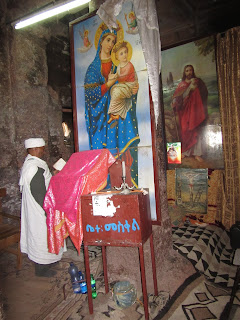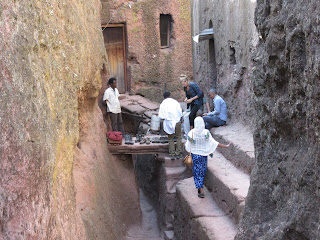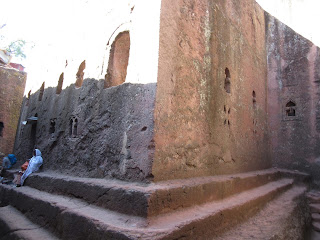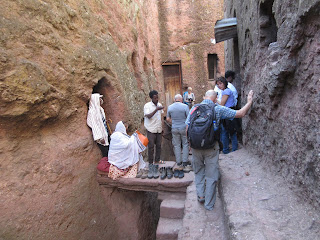Earlier today we arrived in Lalibela from Addis Ababa, the capital of Ethiopia, a town described as arguably the one place in the country no tourist should omit from their itinerary. The draw for tourists is the collection of 13 rock-hewn churches and chapels that functions as a kind of living shrine to King Lalibela, the saint who is accredited with excavating them in the 12th century. After finally arriving in town and then exploring the town's fascinating weekly market, we met with a guide at the ticket office who would take us around some of the churches this afternoon and the rest in the morning.
Wood for sale on the street heading to the ticket office:
The church complex was listed as an UNESCO World Heritage Site in 1978. Our guide, Eshutu, told us that there were four imperial kings who expanded Christianity during the 11th century into Lalibela, which was formerly known as Adefa. The most venerated ruler associated with Adefa was Gebre Meskel Lalibela, the fifth Zagwe emperor, who came to power in the early 1180s and reigned for 40 years.
After studying to be a priest, Lalibela and many others made a pilgrimage to Jerusalem. After his experiences there, he returned to Adefa where he was responsible, Eshutu stated, for the excavation of the rock-hewn churches. Lalibela is known today as the New Jerusalem, Eshutu said, and hundreds of thousands of pilgrims come to Lalibela every January 7th, the birthday of King Lalibela. People stay in tents or in the compound around the churches.
The 13 churches are divided into 3 types: 7 represent Earthly Jerusalem, 5 others represent Heavenly Jerusalem and one symbolizes Noah's Ark. It took 23 years to build all 13 churches, all of which were built from the top down! That was to show where the message is coming from. i.e. from on high, and also that they represent where Jesus was buried in Golgotha in Israel, according to Eshutu. Some have theorized that the oldest excavations might pre-date King Lalibela by many centuries and may even have started life in pre-Christian times as pagan shrines.
It's hard to describe the awesome feeling we had when we climbed the hill and came across this massive church that was standing about 40 feet high below us. Knowing that it and the other churches were built 800 years ago only with chisels and no other supporting materials was almost unbelievable.

Wood for sale on the street heading to the ticket office:
The church complex was listed as an UNESCO World Heritage Site in 1978. Our guide, Eshutu, told us that there were four imperial kings who expanded Christianity during the 11th century into Lalibela, which was formerly known as Adefa. The most venerated ruler associated with Adefa was Gebre Meskel Lalibela, the fifth Zagwe emperor, who came to power in the early 1180s and reigned for 40 years.
After studying to be a priest, Lalibela and many others made a pilgrimage to Jerusalem. After his experiences there, he returned to Adefa where he was responsible, Eshutu stated, for the excavation of the rock-hewn churches. Lalibela is known today as the New Jerusalem, Eshutu said, and hundreds of thousands of pilgrims come to Lalibela every January 7th, the birthday of King Lalibela. People stay in tents or in the compound around the churches.
The 13 churches are divided into 3 types: 7 represent Earthly Jerusalem, 5 others represent Heavenly Jerusalem and one symbolizes Noah's Ark. It took 23 years to build all 13 churches, all of which were built from the top down! That was to show where the message is coming from. i.e. from on high, and also that they represent where Jesus was buried in Golgotha in Israel, according to Eshutu. Some have theorized that the oldest excavations might pre-date King Lalibela by many centuries and may even have started life in pre-Christian times as pagan shrines.
Most of the churches we'd be visiting today were subterranean monoliths or three quarters monoliths, an architrectual style unique to Ethiopia. These excavations mimiced normal buildings in the sense they were free from surrounding rock on three or four sides. The churches were nestled within artificial courtyards and trenches that were cut deeply into the bedrock to leave the free standing block of rock into which the actual church was carved.
King Lalibela also built underground tunnels to connect the churches within the same 23 year span, Eshutu said. In addition, each church had its own drainage system. All the churches' drainage systems connect at a rock-cut stream known rather grandiosely as the River Jordan, one of many place names that support the idea King Lalibela conceived of the churches as a kind of New Jerusalem.
The first church we visited was Bet Medhane Alem, above, which means 'House of the Saviour of the World.' The only reason the church was still standing was because of the original 72 supporting pillars: 36 each on the inside and outside. The three joined at each corner are thought to represent the Holy Trinity. Translucent white shelters were erected at UNESCO's insistence above the church because of threats from seepage. They clashed with the ancinet architecture so I hope at some point they will be replaced when a more suitable design is approved. Restored in 1954, the church was built from one solid piece of volcanic, soft red rock. It's hard to describe the awesome feeling we had when we climbed the hill and came across this massive church that was standing about 40 feet high below us. Knowing that it and the other churches were built 800 years ago only with chisels and no other supporting materials was almost unbelievable.
There was a wide courtyard surrounding the church. Its walls were pockmarked with niches originally carved as graves or hermit cells!
Many windows were needed to provide light into the church. Since Holy Communion was prepared using local firewood, the windows were also used for the smoke to escape.
Each of the churches originally had three entrances: one for men, women and priests. For the last 20 years, men and women have used the same entrance.
Smoke from the fires caused the black discoloration inside the church.
This was formerly the women's entrance.
This was the priests' area of the church. Chanting and music are huge components of the Orthodox Church services and that was why we saw so many drums in each of the churches.
The three empty graves in one corner are said to have been prepared symbolically for Abraham, Isaac and Jacob.
The inside of the church was a collection of small open spaces unlike any religious institution we had ever seen before. You could hear people in another area but couldn't see them. We had to remove our shoes before entering the church. There were carpets on the ground but it was very uneven to walk on.
The interior of the church was very austere.
There was always a 'priest' in each of the churches; although, some people said he was not a priest but a guide instead. Whatever his role was, we were expected to give him a small amount of money. That was on top of the $50 per person fee admission for all the churches and, of course, on top of the guide's fee AND his tip too!
Yes, $50 which we thought was absolutely ridiculous. Sure, the ticket allowed us multiple days of visits but consider this: $50 US is insane when compared to how much we'd spend to visit churches, temples or ruins in any other country. For $50 US, we could visit the Taj Majal 3 times or the Mayan Ruins of Tikal twice, for example. This was par for the course in Ethiopia these days where the ritualistic price gouging of tourists was not only expected but encouraged. Note that these prices were up from about $20 in 2012. What could have accounted for this 2.5x increase? Enough of my rant!
We left Bet Mehane Alem church through the adjoining short, low tunnel that led into a larger courtyard enclosing a trio of churches.
Tradition has it that the largest of these three churches, Bet Maryam, dedicated to the Virgin Mary, was the first church to be excavated at Lalibela. It was smaller and more intimate than Medhane Alem as it stood about 30 feet high and had a floor area of about 750 square feet compared to about 2,500 square feet. There were three porches and seven upper galleries.
Before entering the church, Eshutu showed us the exterior. This was a pool believed to cure any infertile woman who is dipped into the water three times. The water was certainly green and slimy enough to suggest a favorable effect on procreativity! The water level was about 6 feet below the courtyard so the women have to be lowered down on a harnessed rope. That would have been fun to watch, I thought! Eshutu said the pool is still used by local women but only if they believe in its powers.
On one wall we saw two sets of three windows. The upper set is thought to represent the Holy Trinity, while the lower three, set below a small cross-shaped window, are believed to represent the crucifixion of Jesus and the two sinners. The lower right window had a small opening above it, a signal that this sinner was accepted to heaven after repenting his sins and asking for Jesus’ help. The lower left window, which represented the criminal who went to hell, had the small opening below it.
Carved into the northern wall of Bet Maryam's courtyard was the tiny chapel of Bet Meskel or House of the Cross. The ten blind arches on the outside represented the Ten Commandments.
Inside Bet Meskel, we saw the priest who was standing on the very traditional Ethiopian rugs we had seen all over Addis Ababa.
It was normal to have a tall threshold at the entrance to the church.
Crosses were also carved into the ceiling.
The altar area was far more decorated at Bet Meskel than at Bet Medhane Alem.
Eshutu showed us the interior of Bet Maryam Church next.
What a dramatic change it was from the other churches. Highlights of the elaborately decorated interior included carvings of the origianl Lalibela Cross and Star of David and vivid paintings and frescoes on the ceiling and walls.

Above the entrance was a relief of two riders fighting a dragon. We also saw two fighting bulls, one white, one black who were thought to represent good and evil.
There were twelve pillars inside and they represented the 12 Apostles. This veiled pillar was reputedly inscribed with the Ten Commandments in Greek and Ge'ez, an ancient Ethiopian language. Also inscribed was a description of how the churches of Lalibela were excavated as well as the story of the beginning and end of the world. The local priests say that the pillar glowed brightly until the 16th century and claim it would be too dangerous to lift the veil and show it to researchers.
Depicted in the picture were four priest kings of the Zagwe dynasty.
In the southern wall of Bet Maryam was the tiny chapel of Bet Danagel or House of the Virgins which was reputedly constructed in honor of 50 Christian maiden nuns murdered by the Roman ruler Julian the Apostate in the 4th century.
A trench at the southern end of the Bet Maryam courtyard connected it to the twin churches of Bet Golgotha and Bet Mikael or House of Michael and also known as Bet Debre Sina.
After several minutes' walk, the entrance led first to Bet Mikael and then to Bet Golgotha which was named after the hill outside Jerusalem where, according to the Gospels, Jesus Christ was crucified.
The two churches were under one roof and were not the easiest to access. We had to be very careful walking on the narrow ledges as Eshutu instructed us to follow the third level or step to reach the church.
Once there, there was very little room to sit down and remove our shoes as you can see!
The pair of churches had the only cruciform pillars of Lalibela’s churches, i.e. ones shaped like a cross.
The pillars varied from each other. This one had an 'angel eye' in the corner.
This striking 16th C. painting had a number of scenes on it: one image showed Mary with a baby Christ; another showed St. George slaying a dragon. The latter is probably the most common theme in any Ethiopian church as St. George is considered to be the country's patron saint. The vivid colors on the cotton cloth painting were achieved with paints derived from natural plants.
Bet Golgotha is the only church in Lalibela that women are prohibited from entering so Steven took the following photos. Bet Golgotha is known for containing some of the best early examples of Ethiopian Christian art including some amazing life-size depictions of the 12 Apostles carved into the walls’ niches. Four were visible with the other eight behind the curtains in the off-limits Selassie Chapel, one of Lalibela’s holiest sanctuaries and home to more fantastic art and also the reputed tomb of King Lalibela himself.
Drums used by the priests for chanting:
The western exit from the courtyard lay at the base of the Tomb of Adam, a cruciform hermit's cell decorated by mutilated paintings of the Zagwe kings of Lalibela.
Eshutu told us that the cross above the doorway represented Jesus' crucifixion.
Eshutu walked us next through a small village on the way to visiting the next church. He explained that these two story round homes were traditional in this area. Families lived on the upper floor and animals on the lower floor of the grass-roofed homes.
I felt like I imagined a voyeur would feel as we walked among the very simple homes. I asked Eshutu if the villagers resented all the tourists traipsing through their village and he explained that many of them benefit by selling crafts, etc to tourists. We were glad to support the local economy in our own little way too!
Resting off on its own, Bet Giyorgis or St George’s Church is considered to be Lalibela’s masterpiece. Representing the height of the rock-hewn tradition, Bet Giyorgis was the most visually perfect church of all, a 45 foot-high, three-tiered plinth in the shape of a Greek cross. We found that the roofs that helped to protect some of the churches in the Northern group had greatly diminished the overall impression. The difference was evident as we approached Bet Giyorgis church which needed no protective roof and could be admired in its natural state.
The rock hewn churches we had already seen were each a testament to profound faith and engineering. But this site of the Orthodox cross-shaped structure emerging from the ground left us in awe.
Unlike the other churches, Bet Giyorgis had no supporting pillars either inside or outside. Its walls were also much thicker than the others too, Eshutu stated.
When asked, Eshutu stated that the yellow discoloration was due to a kind of algae growing from rain.
The 17 arched windows at the top represented miracles performed by Christ.
We were in no rush to enter the church as we wanted to walk around the perimeter first to see it from all angles.
I must admit to having felt a sense of vertigo as we were so close to the edge but I still couldn't stay away.
To enter the courtyard surrounding the church, we walked along a path that has been carved out of the stone. I'm still astounded that they could build this from the top down out of the rock!
This entrance was for the chanting priests and was in a separate room, located outside the main church.
As we looked up from the courtyard, we got a good sense what a massive feat it had been to build the church. The work that went into constructing all of the churches must have been a mammoth task as they were all so detailed and the planning to carve them from the top down must have involved incredibly skilled craftsmen.
We were able to walk anywhere in all the churches except beind the curtain in each one that had the 'Holy of Holies.'
The church had two 800 year-old olive-wood boxes, one with opposing corkscrew keys, that locals believe were carved by King Lalibela himself. They are believed to have held the tools King Lalibela used to carve the church. They now hold incense that is burned constantly in the church.
Another beautiful painting of St. George slaying the dragon.
Since people stand for almost the entire 2.5 hour long service, sticks are used to prop them up so they don't get tired! The rule for all Ethiopian Orthodox churches, Eshutu told us, is that if you come for a service, you must stay until the end. If you come late, you can't enter! The churches were emphatically not just tourist sites but still used every day by very devout people in the area. What a profound testament to their devotion to Christianity in the midst of such poverty.
This room was maintained for at least one priest to live in at all times so the church was never empty.
Some of the cavities in the walls surrounding the church held mummified corpses.
Some of the holes that were for praying purposes used to be caves.
Bet Giyorgis Church was definitely the most beautiful one of the rock churches we had seen in the Northern Cluster in Lalibela. As someone else wrote, 'it was an unique and enigmatic building created by mankind.'
One of the villagers I bought souvenirs from as we walked back to town.
We saw this monolithic cross in a ravine as we walked back. According to a sign, it was hewn out of the bank of the adjacent River Jordan in order to represent the place of Christ's baptism in the Holy Land.
As we walked back, I thought that Bet Giyorgis Church, a monolith carved out of rock from the top down, had to be one of the most awe inspiring sights in the world due to its location and its perfectly clean design.
The churches of Lalibela are one of the world's greatest treasures. I'm torn about writing about how amazing they are because tourist wise, the town is pretty sparse and it's sort of like discovering something amazing and having it all to yourself. As the churches are also still working 'living' churches, I would also be sad to see Lalibela become swamped with tourists as it would also lead to the erosion of the churches. However, something so beautiful should be seen and protected and if you have a chance this is one of the most amazing things I've seen. Going to Lalibela certainly helps the fledgling tourist industry, too, in Ethiopia.
There were scads of souvenir shops right across from our hotel which I made a point of stopping in at, surprise, surprise. After all, I did need to support the local economy! We loved the variety of the souvenirs all over Ethiopia.
It was encouraging seeing the sign on the main street indicating a child's basic rights.
It was a long day as we had started it in the capital of Addis Ababa, then we flew to Lalibela and had the 'interesting' journey from the airport to town followed by a wonderful stretch of time at the regional market and finally seeing the rock-hewn churches in the Northern Cluster. No wonder the idea of relaxing over a nice dinner sounded heavenly. I ordered beef goulash and Steven had his normal spaghetti but unfortunately, the meat in both was inedible. But, the wine was great and the ambience even better so all was not lost!
Posted from Dubai, United Arab Emirates on December 12th, 2016.




















































































































No comments:
Post a Comment
We love to hear from you!!!!